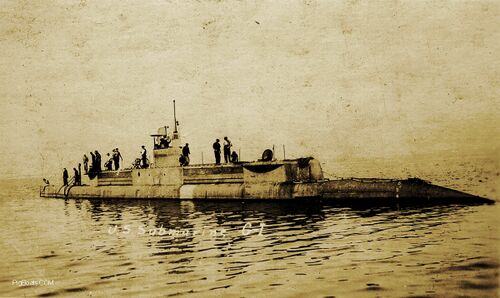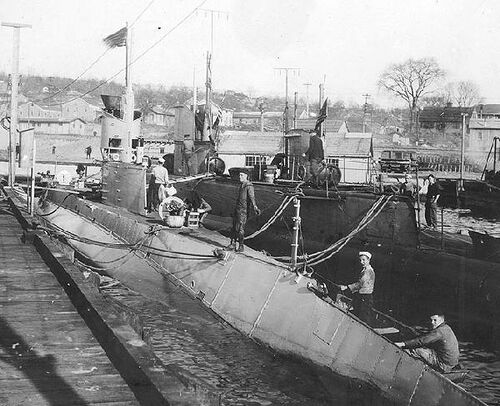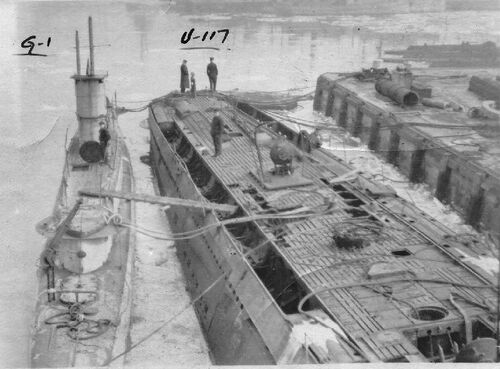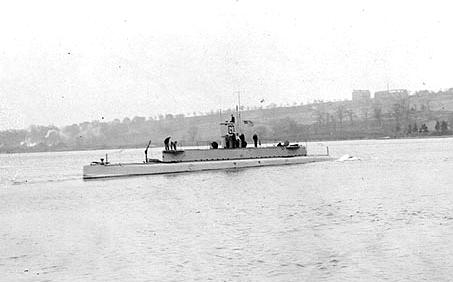G-1: Difference between revisions
Pbcjohnston (talk | contribs) mNo edit summary |
Pbcjohnston (talk | contribs) Added new Header |
||
| (19 intermediate revisions by 2 users not shown) | |||
| Line 1: | Line 1: | ||
[[File:New Header G-class.jpg]] | |||
[[File: | |||
=== <big>Notes</big> === | |||
<div style="text-align: justify;"><span style="color:#00008B">The story of the G-1 is indeed a strange one. The Navy never really wanted the boat, and we speculate that her construction contract was given to Lake to mollify and soothe his vindictive indignation in the wake of the 1907 submarine trials, in which [https://wiki.pigboats.com/images/5/5e/Lake_submarine_of_1906.pdf '''Simon Lake and his submarine ''Lake'' rightfully lost to Electric Boat (EB) and the ''Octopus''''']. The G-1 contract had two important and unprecedented provisos written into it: | |||
1. Lake was to receive NO MONEY for her construction until after he could demonstrate that she could pass ALL of the trial stipulations. In essence he had to foot the entire bill for her construction, fitting out, and trials with no guarantee that he would be reimbursed for anything if she wasn’t accepted. | |||
2. The performance requirements were extremely ambitious for the time, exceeding the performance parameters of any known submarine in the world. | |||
Why would Lake agree to such an ill-advised contract? And why would the Navy offer terms that were so likely to result in Lake failing? Lake had angered a lot of people in the aftermath of the 1907 trials. He openly and loudly accused EB of bribery and accused government officials of corruption. He hired lawyers and pressured congress into appointing an investigative commission to look into the "scandal", merely because he didn’t like the aftermath of the trials. No corruption or evidence of bribery was found, but that didn’t satisfy Lake. | |||
Navy Secretary Metcalf had been apportioned $3,000,000 by a special act for submarine construction and he warily intended to give it all to EB. This of course sent Lake into a tizzy and he threatened another long legal battle. So, Metcalf carved out a chunk and gave it to Lake in February 1908 for the boat that was to become the G-1. We think this was some very astute political maneuvering on behalf of Metcalf. The Navy Department fully recognized that EB had them over a barrel when it came to submarine construction. Because the Navy had no in-house submarine design capability, they had to accept whatever EB offered them. For the most part the Navy got decent boats, but the constant political maneuvering by Isaac Rice and his lawyers had left a bitter taste in the mouth of many Navy Department officials. Everyone wanted EB to have some competition, but when your only other choice was the boastful and vainglorious Lake and his mercurial temper it was seen as the figurative Devil’s Choice. | |||
We believe the 1908 contract to Lake was an attempt to deflect the exasperating inventor and give the Navy time to sort things out. If he failed and went bankrupt then the problem was solved. If he succeeded the Navy would get one hell of a boat and EB would have competition that would keep them honest. It was a win-win for the Navy. Metcalf and his staff expected the chronically underfunded Lake to fail, and thus no hull number was assigned to the contract. | |||
From Lake’s standpoint he could hardly refuse the contract. He had blown a lot of hot air over the last two years about how corrupt the system was and how superior his boats were compared to EB. He demanded a chance to show what he could do and now he was given one. To pass it up would have made him look like a bombastic fool. His pride and ambition got in the way and he accepted. | |||
It took Lake a year to even lay her keel, and two more years to put her in the water. This only reinforced the image that the project was doomed to fail. She barely passed her trials 21 months after being launched. It was not an impressive performance and true to everyone’s prediction it strained Lake and his company to the breaking point. He ran out of cash and resources and was forced to turn over the remainder of the follow-on G-3’s construction to the Brooklyn Navy Yard. | |||
Lake was not paid for the G-1 until 1916! This is despite the fact that the Navy accepted delivery sometime in the fall of 1911 (she was renamed from Seal to G-1 in November) and did not commission her until 28 October 1912. | |||
Then to add to the oddness of the boat, the Navy gave her half a hull number! Why this weird, unprecedented, and potentially comical move was made has been lost to time. It is entirely possible that it was a clerical error and this was how they fixed it. But this brings up a big question: instead of 19½ why not just throw her into the hull number sequence where she fell? If you go by contract date she should have been 13. If you go by commission date she should have been 23. 19½ just doesn’t make any sense and is an odd move. Another explanation could be that this was a form of public rebuke to Lake for this unwanted boat with its anemic performance and ridiculous wheels for rolling on the bottom. Stick this weird number on her to remind everyone what a pariah this boat was. | |||
[[File:G1-1g1-07.jpg| | At any rate, it is interesting that this oddball submarine is still being talked about 100 years later. | ||
[[File:Red bar sub new 2.jpg]] | |||
[[File:G1-4g1(1)-03.jpg|left|500px]] | |||
<div style="text-align: justify;"><span style="color:#00008B">This photo was taken on February 8, 1911 shortly after G-1's launch. At this time she was named Seal. The doors in the superstructure for the trainable torpedo tubes can clearly be seen. Neither the periscope or the supporting shears have yet been added. The men on deck are all Newport News Shipbuilding or Lake company employees. This is the James River, just off Newport News, VA., looking to the west. Carrollton, VA. is in the background, with the entrance to the Nansemond River to the left. | |||
<small>National Archives photo.</small> | |||
[[File:Red bar sub new 2.jpg]] | |||
[[File:G-1 starboard bow.jpg|left|500px]] | |||
Seal shown from the starboard bow during her trials period, 1911. The location is not known for sure, but is likely off Newport News, Virginia where she was built. This photo was definitely taken between the date of her launch on February 8, 1911 and November 17, 1911 when she was renamed G-1. Note that she is flying the "Lake Torpedo Boat Company" pennant from her masthead. | |||
<small>Photo in the private collection of Ric Hedman.</small> | |||
[[File:Red bar sub new 2.jpg]] | |||
[[File:G1-sealg1-04.jpg|left|500px]] | |||
<div style="text-align: justify;"><span style="color:#00008B">The G-1 is seen here prior to her commissioning, probably in the summer of 1912 while running builder's trials. The location is likely somewhere in Hampton Roads, VA., likely in the James River near Newport News. The crew on deck seem to be mostly civilian with a few exceptions. It is hard to see detail due to the poor quality of the photo. There does seem to be an officer on the bow, second from the left and an enlisted man just to the right of the forward ventilator on the higher deck. They seem to be doing something requiring diving as the left most man is clearly stripped down for swimming and there seems to be a man handling a line or hose going over the side. There are deck chairs on the raised deck forward of the bridge. All of her hatches are open. Her name G-1 can been seen at the aft end of the superstructure. | |||
<small>Photo in the private collection of Ric Hedman.</small> | |||
[[File:Red bar sub new 2.jpg]] | |||
[[File:G-1 dry dock- brooklyn ny.jpg|left|500px]] | |||
<div style="text-align: justify;"><span style="color:#00008B">G-1 in drydock at the Brooklyn Navy Yard, October or November of 1912. The doors to the two superstructure mounted torpedo tubes are open. The forward tube in the superstructure can be seen to be rotated to port. The clamshell-like doors on the aft hull covered a large stowage locker for the submarine's motor launch. The small boat was stowed upside down under these doors. The locker was not watertight and free-flooded when the boat dived. | |||
<small>National Archives photo.</small> | |||
[[File:Red bar sub new 2.jpg]] | |||
[[File:G-1 dry dock w crew-1.jpg|left|500px]] | |||
<div style="text-align: justify;"><span style="color:#00008B">G-1 in drydock in Brooklyn, at about the same time as the photo above, fall 1912. This is the starboard side looking aft. On the far right the starboard bow torpedo tube can be seen flared out from the bow. Shoring has been erected on the side of the boat to keep it upright in the dock. Above each set of vertical shoring can be seen the three sets of amidships diving planes. Simon Lake emphasized non-angle diving, and these planes were meant to drive the boat under while maintaining a zero angle. The concept did not work well in practice due to the inability to precisely regulate the fore and aft ballast, making the boat unbalanced and hard to control with the planes centered on her pivot point. The planes are folded up alongside the hull in this photo. The doors for the trainable superstructure torpedo tubes are open, and details of their operating mechanism can be seen. They were a two-piece split affair, with one portion opening upward and the other opening downward. Just forward of the superstructure the oval torpedo loading deck hatch can be seen removed and laying athwartships. Removing this hatch provided access to the watertight hatch inside the superstructure. | |||
<small>Photo from the Rick Larson Collection, now in the private collection of Ric Hedman.</small> | |||
[[File:Red bar sub new 2.jpg]] | |||
[[File:G2-g1icebound2-05.jpg|left|500px]] | |||
<div style="text-align: justify;"><span style="color:#00008B">The G-1 is seen here circa February 1918 frozen solid into about 18 inches of ice on the Thames River at Submarine Base New London, Groton, CT. The bulbous object on the forward deck is a signaling bell, a primitive means of underwater communication. The torpedo loading derrick is in place just forward of the superstructure. An overhaul in 1916 had removed the troublesome trainable torpedo tubes, and in this picture the doors for them have been removed and plated over. There is a tubular frame for a canvas bridge structure erected on the conning tower fairwater, but the canvas itself is not installed. You can also see the helm wheel on the bridge. There is another submarine on the other side of the pier. It is hard to say who it may be, but based on the arrangement of the periscopes it might be the G-2. The arch seen in the background behind the G-1 periscopes looks to be a snow-covered hillside and not the Gold Star Bridge, which hadn't been built at that time. | |||
<small>Photo in the private collection of Ric Hedman.</small> | |||
[[File:Red bar sub new 2.jpg]] | |||
[[File:G1-2g1-06.jpg|left|500px]] | |||
<div style="text-align: justify;"><span style="color:#00008B">An H-class boat (possibly the [[H-1|'''H-1''']] or [[H-2|'''H-2''')]] alongside the G-1 and another unknown submarine. Photo taken circa 1918, possibly at Submarine Base New London, CT. | |||
<small>National Archives photo.</small> | |||
[[File:Red bar sub new 2.jpg]] | |||
[[File:G1-g1u117-08.jpg|left|500px]] | |||
<div style="text-align: justify;"><span style="color:#00008B">G-1 alongside the surrendered German submarine U-117. Photo was most likely taken at the Brooklyn Navy Yard early in 1919. The snowy conditions indicate January or February. U-117 was a long-range minelaying submarine that had operated off the American east coast. She surrendered at Harwich, England on November 21, 1918 and was subsequently turned over to the U.S. An American submarine crew sailed her across the Atlantic for a goodwill tour and technical examination. Note the huge size differential between her and G-1. The German state-of-the-art in submarine technology was the best in the world at the time. G-1 has a permanent metal bridge structure, a lesson learned from the war. | |||
<small>Photo in the private collection of Ric Hedman.</small> | |||
[[File:Red bar sub new 2.jpg]] | |||
[[File:G1-1g1-07.jpg|left|500px]] | |||
<div style="text-align: justify;"><span style="color:#00008B">G-1 getting underway from Submarine Base New London, CT. circa 1919/1920. Her crew is busy stowing the mooring lines. This photo gives a good view of the permanent chariot-style bridge, and shows the smooth sided superstructure after the removal of the trainable torpedo tubes. | |||
<small>National Archives photo.</small> | |||
[[File:Red bar sub new 2.jpg]] | |||
<center>[[G-class|Return to the G-class page]] | [[Submarine Classes|Return to the Submarine Classes page]]</center> | |||
[[File:Red bar sub new.jpg]] | |||
<center> | |||
<span style="color:#00008B"> | |||
Page created by:<br> | |||
<small>Ric Hedman & David Johnston<br> | |||
1999 - 2023 - PigBoats.COM<sup>©</sup><br> | |||
Mountlake Terrace, WA, Norfolk, VA<br> | |||
webmaster at pigboats dot com</small> | |||
</center> | |||
[[File:Subs bottom line 2.jpg]] | |||
Latest revision as of 20:15, 13 March 2025
Notes
1. Lake was to receive NO MONEY for her construction until after he could demonstrate that she could pass ALL of the trial stipulations. In essence he had to foot the entire bill for her construction, fitting out, and trials with no guarantee that he would be reimbursed for anything if she wasn’t accepted.
2. The performance requirements were extremely ambitious for the time, exceeding the performance parameters of any known submarine in the world.
Why would Lake agree to such an ill-advised contract? And why would the Navy offer terms that were so likely to result in Lake failing? Lake had angered a lot of people in the aftermath of the 1907 trials. He openly and loudly accused EB of bribery and accused government officials of corruption. He hired lawyers and pressured congress into appointing an investigative commission to look into the "scandal", merely because he didn’t like the aftermath of the trials. No corruption or evidence of bribery was found, but that didn’t satisfy Lake.
Navy Secretary Metcalf had been apportioned $3,000,000 by a special act for submarine construction and he warily intended to give it all to EB. This of course sent Lake into a tizzy and he threatened another long legal battle. So, Metcalf carved out a chunk and gave it to Lake in February 1908 for the boat that was to become the G-1. We think this was some very astute political maneuvering on behalf of Metcalf. The Navy Department fully recognized that EB had them over a barrel when it came to submarine construction. Because the Navy had no in-house submarine design capability, they had to accept whatever EB offered them. For the most part the Navy got decent boats, but the constant political maneuvering by Isaac Rice and his lawyers had left a bitter taste in the mouth of many Navy Department officials. Everyone wanted EB to have some competition, but when your only other choice was the boastful and vainglorious Lake and his mercurial temper it was seen as the figurative Devil’s Choice.
We believe the 1908 contract to Lake was an attempt to deflect the exasperating inventor and give the Navy time to sort things out. If he failed and went bankrupt then the problem was solved. If he succeeded the Navy would get one hell of a boat and EB would have competition that would keep them honest. It was a win-win for the Navy. Metcalf and his staff expected the chronically underfunded Lake to fail, and thus no hull number was assigned to the contract.
From Lake’s standpoint he could hardly refuse the contract. He had blown a lot of hot air over the last two years about how corrupt the system was and how superior his boats were compared to EB. He demanded a chance to show what he could do and now he was given one. To pass it up would have made him look like a bombastic fool. His pride and ambition got in the way and he accepted.
It took Lake a year to even lay her keel, and two more years to put her in the water. This only reinforced the image that the project was doomed to fail. She barely passed her trials 21 months after being launched. It was not an impressive performance and true to everyone’s prediction it strained Lake and his company to the breaking point. He ran out of cash and resources and was forced to turn over the remainder of the follow-on G-3’s construction to the Brooklyn Navy Yard.
Lake was not paid for the G-1 until 1916! This is despite the fact that the Navy accepted delivery sometime in the fall of 1911 (she was renamed from Seal to G-1 in November) and did not commission her until 28 October 1912.
Then to add to the oddness of the boat, the Navy gave her half a hull number! Why this weird, unprecedented, and potentially comical move was made has been lost to time. It is entirely possible that it was a clerical error and this was how they fixed it. But this brings up a big question: instead of 19½ why not just throw her into the hull number sequence where she fell? If you go by contract date she should have been 13. If you go by commission date she should have been 23. 19½ just doesn’t make any sense and is an odd move. Another explanation could be that this was a form of public rebuke to Lake for this unwanted boat with its anemic performance and ridiculous wheels for rolling on the bottom. Stick this weird number on her to remind everyone what a pariah this boat was.
At any rate, it is interesting that this oddball submarine is still being talked about 100 years later.

National Archives photo.

Seal shown from the starboard bow during her trials period, 1911. The location is not known for sure, but is likely off Newport News, Virginia where she was built. This photo was definitely taken between the date of her launch on February 8, 1911 and November 17, 1911 when she was renamed G-1. Note that she is flying the "Lake Torpedo Boat Company" pennant from her masthead.
Photo in the private collection of Ric Hedman.

Photo in the private collection of Ric Hedman.

National Archives photo.

Photo from the Rick Larson Collection, now in the private collection of Ric Hedman.

Photo in the private collection of Ric Hedman.

National Archives photo.

Photo in the private collection of Ric Hedman.

National Archives photo.
Page created by:
Ric Hedman & David Johnston
1999 - 2023 - PigBoats.COM©
Mountlake Terrace, WA, Norfolk, VA
webmaster at pigboats dot com
